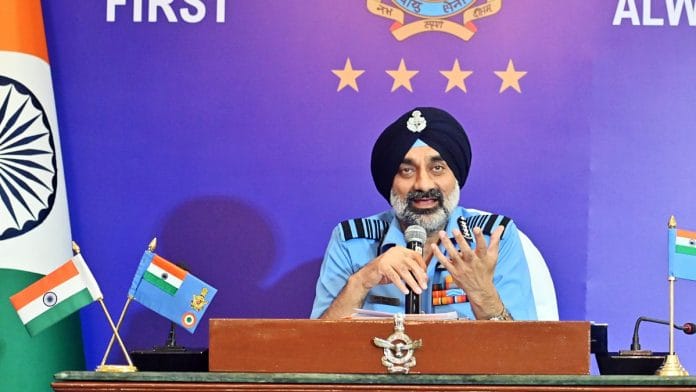New Delhi: In a candid assessment of his force, IAF chief Air Chief Marshal A.P. Singh Friday acknowledged that the force lags in terms of technological advancements and must catch up with others.
He also expressed willingness to choose Indian-made products, even if they offer 85 percent of the capabilities of their global counterparts.
Speaking at a seminar hosted by the Chanakya Forum, ACM Singh emphasised that India must explore collaborative projects between foreign firms and Indian private players to produce fighter aircraft domestically, supplementing the state-run Hindustan Aeronautics Limited’s (HAL) production of the Tejas Mk-1A.
ACM Singh’s comments pointed directly to the long-pending Medium Multi-Role Fighter Aircraft (MRFA) programme, which envisions the procurement of 114 new fighter jets. Some of these will be acquired from abroad in flyaway condition, while others will be made in India.
This move is part of the IAF’s broader strategy to procure 126 aircraft, an effort since 2000 that culminated in the Narendra Modi government’s emergency purchase of 36 Rafale fighters in 2016.
However, the IAF’s numbers remain a concern. As of now, the IAF operates only 31 squadrons of fighter jets—well below the sanctioned strength of 42. In reality, even these 31 squadrons are somewhat inflated, as two squadrons of MiG-21s have been merged to meet the required numbers.
Looking ahead, ACM Singh stressed the need for India to prepare for future conflicts, which he believes will be defined by advanced technology and protracted engagements.
“We cannot afford to fight wars of the past, we must fight the wars of the future,” he said, advocating for a more forward-thinking approach to defence preparedness.
Also read: IAF Chief’s anger at HAL is justified. The cost of inefficiency is borne by pilots
Homegrown would be IAF’s 1st preference
Acknowledging the challenges, ACM Singh reiterated that the IAF’s first preference would be to prioritise homegrown systems.
“Even if a domestic system delivers 85 percent or 90 percent of the performance offered by international products, we would still choose to go with the homegrown option,” he said.
However, he acknowledged that developing such systems will take time, and in the meantime, the IAF must quickly fill the gaps.
“At the same time, while we are doing this, we will have to look at systems that are available but made in India. That will give us a boost because new technology will come to India at a quicker pace,” he said, adding that it will also increase the production capacity for homegrown systems.
“I can take a vow that I will not buy anything from outside or I will wait for whatever is developed in India, but it may not be possible if it does not come at that pace. At the moment, we all know that we are very badly off when it comes to numbers. And the numbers which were promised are also coming a little slow. So, there will be a requirement to go and look for something which can quickly fill up these voids,” he said.
He was referring to the delayed delivery of the Tejas MK-IA fighters, which was set to begin in February last year but has yet to start.
“We did an exercise in house. We need to actually produce or induct aircraft at the rate of two squadrons per year to cater for the ramped-up numbers we want and whatever will go out very soon,” he said. “We have a lot of fleets that, in another 5-10 years, we’ll have to phase out. So those fleets will have to be filled up also. Plus, we already have vacancies. So, we are looking at inducting 35-40 aircraft a year that are to be produced somewhere. I understand those capacities cannot come overnight but we need to start pushing ourselves towards that,” he said.
He was referring to the Mirage 2000, Jaguar, and MiG-29 fleets, which are set to begin being phased out from 2030.
The IAF chief noted that HAL has promised to start delivery of 24 LCA MK-IA. “So, I am very happy. If we are talking about 24 aircraft of MK1A, plus some Sukhois or other aircraft, we are looking at 30 aircraft per year by HAL alone.
“Along with that, if we have a private player coming in, we have a very good model of transport aircraft at this moment, if the private industry comes in for Make India, we add another 12-18 from that side. So, we are reaching there, it is possible. We need to make sure that we don’t lose steam while we are pushing it,” he said.
He was referring to the model of C-295 transport aircraft which is being manufactured in India through a partnership between TATA and the Spanish arm of the European firm Airbus.
(Edited by Zinnia Ray Chaudhuri)






